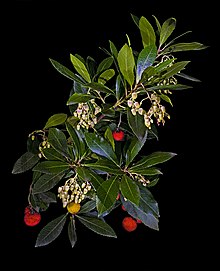Arbutus
| Arbutus | |
|---|---|
 |
|
| Arbutus unedo | |
| Scientific classification | |
| Kingdom: | Plantae |
| (unranked): | Angiosperms |
| (unranked): | Eudicots |
| (unranked): | Asterids |
| Order: | Ericales |
| Family: | Ericaceae |
| Subfamily: | Arbutoideae |
| Genus: |
Arbutus L. |
| Type species | |
|
Arbutus unedo L. 1753 |
|
| Species | |
|
See text. |
|
See text.
Arbutus is a genus of 11 accepted species of flowering plants in the family Ericaceae, native to warm temperate regions of the Mediterranean, western Europe, the Canary Islands (Teneriffa) and North America. The name is borrowed from Latin, where it referred to A. unedo.
Arbutus are small trees or shrubs with red flaking bark and edible red berries. Fruit development is delayed for about five months after pollination, so that flowers appear while the previous year's fruit are ripening.
Members of the genus are called madrones or madronas in the United States, from the Spanish name madroño (strawberry tree). In Canada—in British Columbia, where the species is common—arbutus is commonly used or, rarely and locally, "tick tree." All refer to the same species, Arbutus menziesii, native to the Pacific Northwest and Northern California regions. It is Canada's only native broadleaved evergreen tree. Some species in the genera Epigaea, Arctostaphylos and Gaultheria were formerly classified in Arbutus. As a result of its past classification, Epigaea repens (mayflower) has an alternative common name of "trailing arbutus".
A study published in 2001 which analyzed ribosomal DNA from Arbutus and related genera suggests that Arbutus is paraphyletic and the Mediterranean Basin species of Arbutus are more closely related to Arctostaphylos, Arctous, Comarostaphylis, Ornithostaphylos and Xylococcus than to the western North American species of Arbutus, and that the split between the two groups of species occurred at the Paleogene/Neogene boundary.
...
Wikipedia
